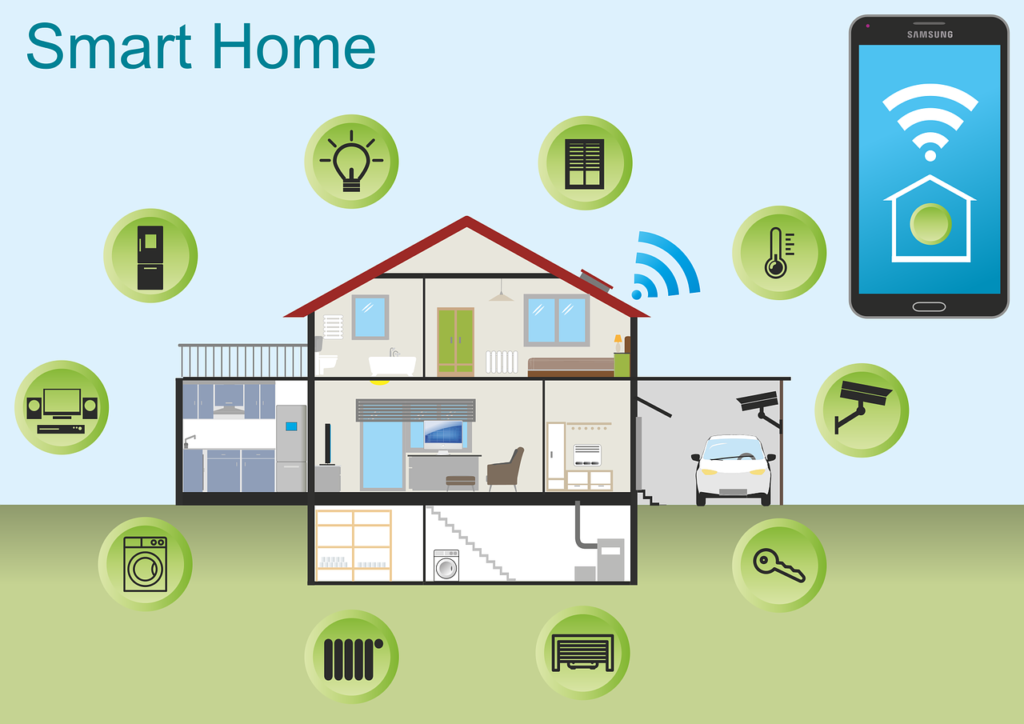How Smart Home Tech is Shaping the Future of Living
Transform your daily routine, save money, and create the home of your dreams with cutting-edge smart technology that’s more accessible than ever before.
The future isn’t coming—it’s already here, humming quietly in millions of homes around the world. Smart home technology has evolved from science fiction fantasy to everyday reality, fundamentally changing how we interact with our living spaces. Whether you’re a tech enthusiast or someone who simply wants a more comfortable, efficient home, the revolution happening in smart home innovation offers unprecedented opportunities to enhance your quality of life.
This isn’t just about having the coolest gadgets or impressing your neighbors. Smart home technology represents a fundamental shift toward more sustainable, secure, and personalized living experiences that adapt to your unique needs and preferences.
The Current Smart Home Revolution: Beyond the Hype
What Makes Today’s Smart Homes Different
Gone are the days when smart homes were expensive curiosities reserved for tech billionaires. Today’s smart home ecosystem is characterized by affordability, interoperability, and genuine utility that solves real-world problems.
Modern smart homes integrate multiple systems through centralized platforms, creating seamless experiences that learn and adapt. Instead of isolated gadgets that require separate apps, today’s solutions work together, communicating through protocols like Zigbee, Z-Wave, and Matter to create truly connected environments.
The Accessibility Factor: Smart Tech for Everyone
The democratization of smart home technology means that transforming your living space no longer requires a massive budget or technical expertise. Entry-level smart devices now cost less than traditional alternatives while offering superior functionality and long-term savings.
Key accessibility improvements include:
- Plug-and-play installation for most devices
- Voice control eliminating the need for smartphone dependency
- Affordable starter kits under $200
- Universal compatibility across major platforms

Game-Changing Technologies Transforming Modern Living
Artificial Intelligence: Your Home’s New Brain
Artificial intelligence has moved beyond simple automation to predictive intelligence that anticipates your needs. Modern AI-powered homes learn your patterns, preferences, and behaviors to create personalized experiences that evolve over time.
Real-world AI applications:
- Predictive climate control that adjusts temperature based on weather forecasts, occupancy patterns, and energy rates
- Intelligent lighting systems that optimize for circadian rhythm health and mood enhancement
- Adaptive security that recognizes familiar faces and unusual patterns
Internet of Things (IoT): Creating Connected Ecosystems
The Internet of Things transforms everyday objects into intelligent, connected devices that share information and coordinate actions. This connectivity enables sophisticated automation scenarios that would have been impossible just a few years ago.
Transformative IoT implementations:
- Smart appliances that coordinate meal planning and grocery ordering
- Interconnected sensors that monitor air quality, humidity, and environmental factors
- Integrated entertainment systems that follow you from room to room
Voice Control and Natural Language Processing
Voice assistants have evolved from novelty items to essential home management tools. Advanced natural language processing now enables complex, conversational interactions that feel genuinely helpful rather than robotic.
Advanced voice capabilities include:
- Multi-step command execution
- Context-aware responses
- Personalized voice recognition for family members
- Integration with third-party services and devices
Read More – Discover the 5 Best VR Games That Will Captivate You In 2025
Revolutionary Applications Reshaping Daily Life
Energy Management: Smart Savings and Sustainability
Smart energy management represents one of the most impactful applications of home technology, offering both environmental benefits and significant cost savings.
Intelligent Power Optimization
Modern smart homes monitor and optimize energy consumption in real-time, identifying inefficiencies and automatically adjusting usage patterns. Smart thermostats, for example, can reduce heating and cooling costs by up to 23% through intelligent scheduling and occupancy detection.
Solar Integration and Battery Storage
The integration of solar panels with smart battery storage systems and intelligent load management creates homes that can achieve energy independence while contributing to grid stability. These systems automatically optimize when to store, use, or sell energy back to the grid based on real-time pricing and consumption patterns.
Action step: Start with a smart thermostat and smart plugs to monitor your energy usage patterns and identify the biggest opportunities for savings in your home.
Security and Safety: Peace of Mind Through Technology
Smart security systems have evolved far beyond simple cameras and alarms to create comprehensive safety ecosystems that protect both property and people.
Predictive Security Systems
Advanced security systems use machine learning to distinguish between normal and suspicious activity, reducing false alarms while increasing actual security. These systems can recognize family members, regular visitors, and delivery personnel while alerting you to genuine concerns.
Health and Safety Monitoring
Smart homes now monitor for health emergencies, gas leaks, water damage, and fire risks with unprecedented accuracy. Integrated sensors can detect falls, medical emergencies, or environmental hazards and automatically contact appropriate emergency services.
Privacy-First Approaches
Leading smart security solutions now offer local processing and encrypted communications, ensuring that your privacy is protected while maintaining security effectiveness.
Action step: Begin with a smart doorbell camera and gradually expand to include motion sensors and smart locks that integrate with your smartphone for comprehensive yet user-friendly security.
Health and Wellness: Your Home as a Health Partner
The convergence of health technology and smart homes creates living environments that actively support physical and mental well-being.
Air Quality and Environmental Health
Smart air quality monitors track pollutants, allergens, and volatile organic compounds, automatically adjusting ventilation systems and air purifiers to maintain optimal indoor environments. This technology is particularly valuable for family members with asthma or allergies.
Circadian Rhythm Optimization
Intelligent lighting systems now adjust color temperature and brightness throughout the day to support healthy sleep cycles and improve mood. These systems can simulate natural daylight patterns, especially beneficial during winter months or for shift workers.
Wellness Tracking and Automation
Smart homes can monitor sleep quality, physical activity, and stress levels, creating environments that support wellness goals through automated adjustments to lighting, temperature, and sound.
Action step: Install smart lighting that adjusts color temperature throughout the day and add an air quality monitor to create a healthier living environment immediately.
Emerging Technologies: The Next Wave of Innovation
Extended Reality (XR) Integration
The integration of virtual reality, augmented reality, and mixed reality technologies into smart homes will create immersive experiences for entertainment, education, and remote work. Future homes will feature dedicated XR spaces with environmental controls that enhance virtual experiences.
Advanced Robotics: Beyond Vacuum Cleaners
Next-generation home robots will handle complex tasks like meal preparation, laundry folding, and elderly care assistance. These robots will integrate seamlessly with smart home systems to coordinate their activities with household schedules and preferences.
Biometric and Emotion Recognition
Future smart homes will recognize emotional states through facial expression analysis, voice tone, and physiological markers, automatically adjusting environment and entertainment to support mental health and well-being.
Quantum Computing Applications
As quantum computing becomes more accessible, smart homes will leverage quantum processors for complex optimization problems, enabling unprecedented energy efficiency and predictive capabilities.
Economic Impact: Smart Homes as Financial Investments
Property Value Enhancement
Homes equipped with smart technology consistently command higher resale values and sell faster than traditional properties. Real estate professionals report that smart home features can increase property values by 3-15%, depending on the sophistication and integration of the technology.
Long-Term Cost Savings
The initial investment in smart home technology typically pays for itself through reduced utility bills, lower insurance premiums, and decreased maintenance costs. Smart homes can reduce overall living expenses by 10-25% over time.
New Economic Opportunities
Smart homes enable new income streams through energy trading, home sharing optimization, and remote work capabilities that increase property utilization and value.
Action step: Research smart home upgrades that provide the highest return on investment in your area, typically starting with smart thermostats, security systems, and energy-efficient lighting.
Environmental Impact: Sustainable Living Through Technology
Carbon Footprint Reduction
Smart homes significantly reduce environmental impact through optimized energy consumption, waste reduction, and resource conservation. Studies show that fully integrated smart homes can reduce carbon emissions by 30-50% compared to traditional homes.
Water Conservation
Smart irrigation systems, leak detection, and water usage monitoring help homeowners reduce water consumption while maintaining beautiful landscapes and preventing costly damage.
Waste Management Optimization
Smart waste management systems track consumption patterns, optimize recycling, and reduce overall waste through predictive shopping and consumption analytics.
Social and Cultural Transformation
Changing Lifestyle Patterns
Smart homes are reshaping how families interact with their living spaces, creating more flexible, responsive environments that adapt to changing needs throughout the day and across life stages.
Aging in Place Solutions
Smart home technology enables older adults to remain in their homes longer and more safely through health monitoring, fall detection, medication reminders, and emergency response systems.
Remote Work Integration
The shift toward remote work has accelerated smart home adoption, with technology creating dedicated work spaces that optimize productivity, comfort, and work-life balance.
Getting Started: Your Smart Home Journey
Phase 1: Foundation Building (Months 1-3)
Start with essential systems that provide immediate benefits and form the foundation for future expansion:
- Smart thermostat: Begin saving money immediately while learning smart home basics
- Smart lighting starter kit: Experience the convenience of automated and voice-controlled lighting
- Smart security camera: Enhance safety while gaining familiarity with smart home apps
- Voice assistant: Create a central control point for your growing smart home ecosystem
Phase 2: Expansion and Integration (Months 4-12)
Build upon your foundation with devices that integrate and enhance your existing systems:
- Smart locks and door sensors: Complete your security system while adding convenience
- Smart appliances: Upgrade major appliances as they need replacement with smart alternatives
- Advanced sensors: Add environmental monitoring for air quality, humidity, and temperature
- Entertainment integration: Connect smart TVs, speakers, and streaming devices
Phase 3: Optimization and Advanced Features (Year 2+)
Implement sophisticated systems that provide advanced automation and optimization:
- Whole-home energy management: Install solar panels, battery storage, and smart panels
- Advanced automation: Create complex scenes and routines that anticipate your needs
- Health and wellness systems: Add sleep tracking, air purification, and wellness monitoring
- Emerging technologies: Stay current with new innovations and integrate promising solutions
Budget-Conscious Approach
Transform your home gradually with strategic investments:
- Under $500: Smart thermostat, basic lighting, voice assistant, and security camera
- $500-1,500: Add smart locks, environmental sensors, and basic automation
- $1,500-5,000: Integrate major appliances, advanced security, and comprehensive lighting
- $5,000+: Implement whole-home systems, renewable energy, and cutting-edge technologies
Overcoming Common Concerns and Challenges
Privacy and Security
Concern: “I’m worried about data privacy and security vulnerabilities.”
Solution: Choose devices from reputable manufacturers with strong privacy policies, use secure networks, regular software updates, and consider local processing options that don’t rely on cloud connectivity.
Technical Complexity
Concern: “Smart homes seem too complicated for me to manage.”
Solution: Start simple with plug-and-play devices, focus on single-function solutions initially, and gradually build complexity as you gain comfort and experience.
Cost Considerations
Concern: “Smart home technology is too expensive.”
Solution: Begin with affordable, high-impact devices, focus on solutions that provide immediate savings, and build your system gradually over time rather than all at once.
Reliability Concerns
Concern: “What happens when the technology fails?”
Solution: Choose devices with manual overrides, invest in reliable internet infrastructure, and maintain some traditional backups for critical systems.
The Future Landscape: Preparing for Tomorrow’s Home
Anticipated Developments (2024-2027)
- Matter protocol adoption enabling universal device compatibility
- Edge computing integration reducing dependence on internet connectivity
- Advanced AI personalization creating truly adaptive living environments
- Renewable energy integration becoming standard in new construction
Long-term Vision (2027-2035)
- Fully autonomous homes that manage themselves with minimal human input
- Health-centric design with homes that actively monitor and improve occupant well-being
- Climate adaptation technology that responds to changing environmental conditions
- Community integration connecting homes to create smart neighborhoods and cities
Preparing for the Future
Stay ahead of the curve by:
- Choosing future-proof technologies with open standards and regular updates
- Building flexible infrastructure that can accommodate new devices and capabilities
- Staying informed about emerging trends and technologies
- Participating in smart home communities to learn from other users’ experiences
Taking Action: Your Next Steps
The future of living is being written today, and you have the opportunity to be an active participant rather than a passive observer. Smart home technology offers unprecedented opportunities to create living spaces that are more comfortable, efficient, secure, and sustainable than ever before.
Your 30-Day Challenge
Commit to taking these concrete steps over the next month:
Week 1: Research and purchase your first smart home device (recommend starting with a smart thermostat or smart lighting starter kit)
Week 2: Install and configure your device, exploring all available features and integrations
Week 3: Track the impact on your daily routine, energy usage, and overall satisfaction
Week 4: Plan your next smart home addition based on your experience and identified needs
Building Your Smart Home Community
Connect with others on the same journey:
- Join online forums and communities dedicated to smart home technology
- Attend local maker spaces or smart home meetups
- Share your experiences and learn from others’ successes and challenges
- Stay curious about new developments and emerging technologies
Conclusion: Embracing the Smart Living Revolution
The transformation of our homes through smart technology represents more than just convenience or novelty—it’s about creating living spaces that actively support our health, happiness, and goals while contributing to a more sustainable future for everyone.
Every small step you take toward a smarter home is an investment in your future quality of life and a contribution to the larger movement toward more efficient, sustainable living. The technology exists today to begin transforming your home, and it’s more accessible and affordable than ever before.
The question isn’t whether smart homes will become the standard—they already are. The question is whether you’ll be an early adopter who enjoys the full benefits of this transformation or someone who catches up later after missing years of improved living.
Your smart home journey begins with a single device, a single automation, a single step toward the future. The home of your dreams is waiting—not in some distant future, but today, with technology that’s ready to transform how you live.
Start today. Your future self will thank you
Follow us on








